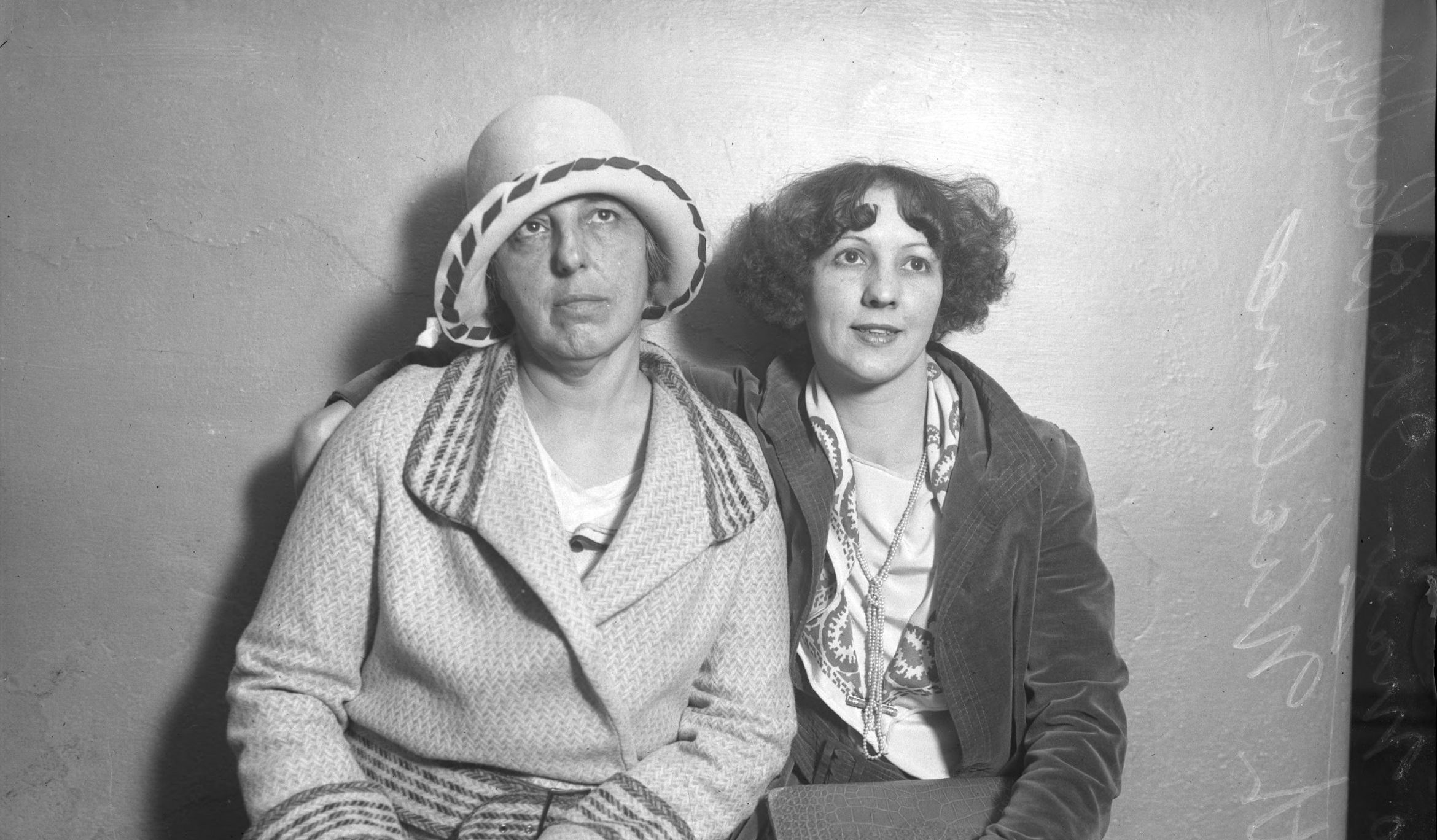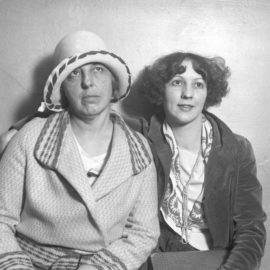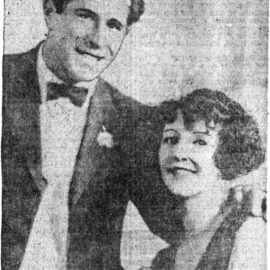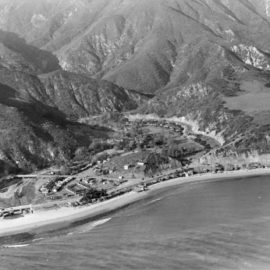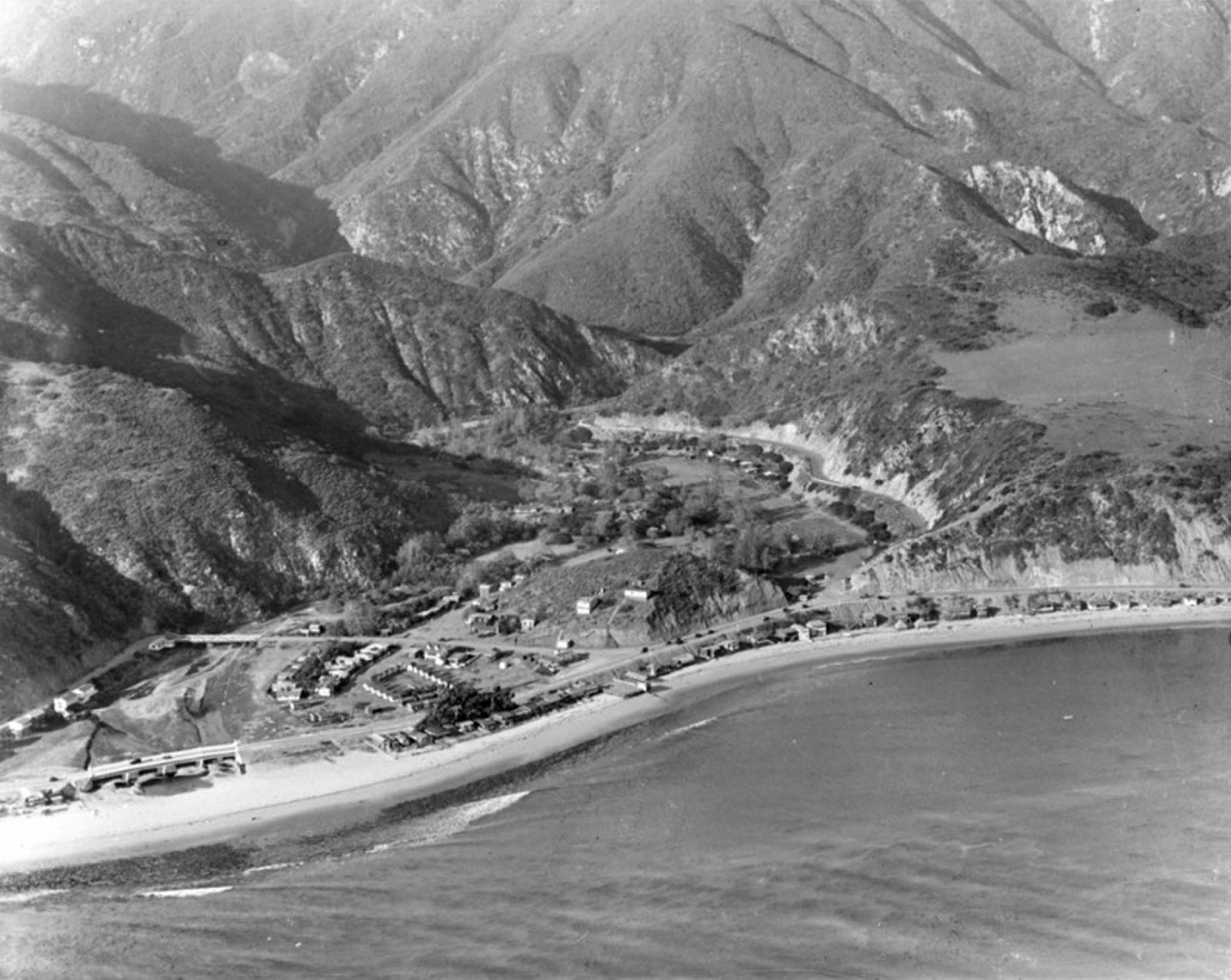The Great Eleven Cult in Topanga
May Otis Blackburn and Ruth Wieland in court, 1929. Photos submitted by the author
Source: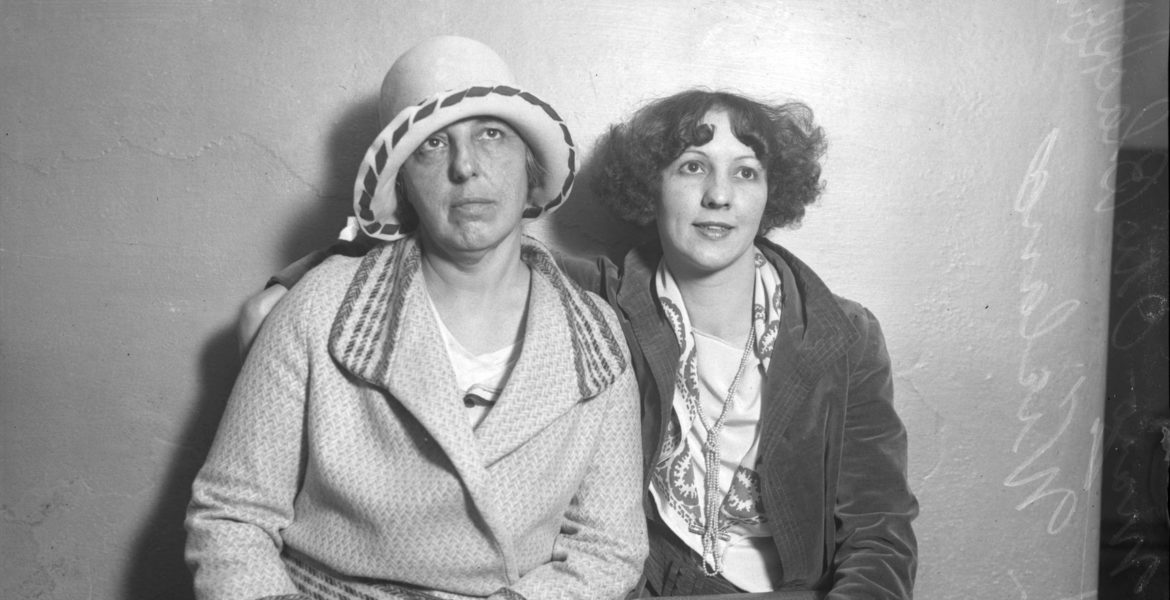
An unusual Topanga Beach sight in August 1924 would have been Sam Rizzio, 18, walking back and forth, repeating, “I am a dead man,” while a woman sprinkled a vial to wet the sand under his bare feet.
Sam (1907-1924?) was being converted to the mysterious religion of his new wife, Ruth Wieland, 25, called The Divine Order of The Royal Arms of The Great Eleven. The ceremony was intended to break him away from his old beliefs.
Ruth (1899-1978) and her mother May Otis Blackburn (1881-1951) had created The Great Eleven religion after failing to find success in Hollywood, despite starring in and producing Portland, Oregon’s first feature film, A Nugget in the Rough (1917). They’d moved to Los Angeles in 1918, but by 1922, Ruth was supporting them by working downtown as a “taxi dancer,” the early 20th century’s less risqué version of a lap dancer, and sometimes an audition before prostitution.
That’s when Ruth and May said the biblical angel Gabriel had appeared to them, telling them that he would help them write a book called The Sixth Seal, whose publication would bring about the end of the known world.
“They had been taken to a spot outside of Bakersfield, where just below the surface of the earth they were shown huge stores of golden nuggets and precious stones—which was to be theirs upon the presentation to the world of The Sixth Seal. The Royal Family of the Chosen Eleven was to consist of nine ‘queens’ and Ruth and May. For each queen a marble palace was to be erected on the Mount of Olives [Barnsdall Park] in Hollywood, and was to be supplied with eleven ‘kings’ chosen by the Angel Gabriel. The queens and their respective entourages were to rule the world with the advent of eternal life.” (“Angel Gabriel Girls Quizzed,” Los Angeles Times, 2-7-1925)
While this was the gospel that the women preached, their religion was really about promising greedy people access to the mythical treasures if they would invest now in the production of The Sixth Seal, and about doing whatever Ruth and May said, no matter how irrational, because the angel had told them it was needed to bring the universe into harmony.
Sam had only known Ruth a short time when he married her in May 1924 and moved into her religious cult’s headquarters, where Koreatown’s MaDang Mall is today. He soon grew tired of the fanaticism there, and begged Ruth to run away with him. During one argument, he supposedly hit her so hard that he drew blood, causing the cultists to form a wall around their queen. However, most accounts of what happened within the cult should be questioned because they come from Ruth and May, who were deranged liars.
After the fight, Ruth said Sam had abruptly packed his things and left. She told Sam’s mother that he was doing religious work as penance and would return when it was done. Later, she spookily phrased it as, “he is now a high priest, invisible to less spiritual eyes.” To corroborate her story, she showed a short letter that she’d received from Sam.
“I am sorry that I have been so mean to you. I should have realized that after so many years of hard work that you have had in writing The Sixth Seal and the great sacrifices you have made that you were not strong and able to stand my abuse. This is good-bye.” (“Threats Sent Cult Accuser,” Los Angeles Times, 10-8-1929)
The irony of Ruth and May basing their religion on producing a book is that they were bad writers, afflicted by the same lack of subtlety as Sam’s dubious letter. One of the few people privileged to have seen a draft of the The Sixth Seal called it “the most astounding, bewildering hodge-podge of biblical and mythological references,” which is probably why its release was constantly delayed, and then never happened. In 1936, May would finally publish their only book, The Origin of God, which was similarly flawed.
“…there is a lot of repetition that the author insists is necessary to really pound home her point, though a cynic might observe there are so few ideas that the repetition’s real purpose was to generate enough material for a book.” (Cult of the Great Eleven by Samuel Fort, Nisirtu Publishing, 2014)
Sam’s younger brother Frank Rizzio immediately suspected that the letter was a forgery. He decided to do his own snooping and infiltrated the cult by getting May to hire him as her chauffeur. When, after only a few days, he discovered Sam’s clothes and suitcase, May tersely responded that maybe it meant Sam would be coming back soon.
The Rizzios threatened to go to the police, but never did, perhaps because they were trying to escape their own criminal past. Sam had already served nine months in juvenile hall for altering checks, and his father had been wanted for a triple homicide in Chicago in connection with the Black Hand gang, a precursor to the Mafia.
Sam’s disappearance would only be properly investigated five years later, when Ruth and May were arrested for defrauding their followers. Handwriting analysts reviewed his letter and noted that it had the same misspellings as Ruth’s writing. They also determined that a second letter sent to Sam’s mother couldn’t have been written by him because he was left-handed.
The 1929 trial was the first time that the public learned about Sam’s Topanga Beach ceremony. According to a pharmacist in the cult, May had said that the angel wanted her to kill Sam with a poison “which cannot be detected in the body of a drowned man,” but told her not to worry because he would be resurrected after The Sixth Seal was published. A few weeks later, May said that Sam only needed to die a symbolic death by walking through the poison. The pharmacist told police that she’d given May a vial of colored water in fear…but perhaps she lied, and perhaps May’s angel changed his mind again.
While Frank was still working as May’s chauffeur, he noticed the disappearance of another teenager in the cult, Willa Rhoads, 16. May told him that Willa had gotten a job teaching in Altadena. Others said that she’d gone east to marry.
During the 1929 trial, Willa’s parents broke down and confessed that she was dead, revealing one of the cult’s darkest secrets. According to their story, May had summoned them from Portland in November 1924 to install Willa as one of the 11 queens who would rule the world from Hollywood. Upon her arrival, an excited Willa was gifted seven puppies named after the seven syllables in solfège (sol-fa syllables in a musical scale or melody). On Christmas Day, she developed a tooth infection, but the family refused to see a doctor. Instead, they told her that she would die and be resurrected when The Sixth Seal was published. Willa apparently accepted this and died on New Year’s Day.
To accomplish the resurrection, May ordered that Willa’s body be laid on ice and preserved in salt and spices. Then she ordered the same thing for Willa’s puppies, which had to be poisoned first, saying that they would help Willa awaken at the seven notes of the angel Gabriel’s trumpet.
Willa and the puppies were kept frozen for more than a year, requiring deliveries of 600 lbs. of ice a week. In addition, the cult moved three times with the frozen bodies, one of their headquarters being the future site of Santa Monica’s trendy Urth Caffé.
In February 1926, May said that Willa’s resurrection wasn’t going to happen as soon as she’d thought, and told Willa’s parents to bury the bodies under the floorboards of their Venice home. Police found Willa and the puppies there in 1929.
May claimed that Willa had been “sacrificed to save the world,” making it sound like she’d planned Willa’s death. The summons to Los Angeles, the gift of the puppies, the sudden illness, and the portentous dates also suggested this. Willa was even reported to have been feeling better on New Year’s Eve and celebrated with the cultists before her sharp decline the next day, as if poisoned.
And was it a coincidence that Sam Rizzio had been hastily brought into the cult only to disappear like Willa? Was it a coincidence that they were close in age, and that their disappearances happened within months of each other?
In February 1925, a small metal box was found at a construction site in Topanga near Fernwood. It contained photos of May with a wealthy Portland businessman named Fremont Everett, financial papers showing gifts amounting to $100,000, and old love letters. This discovery forced May to admit that she’d had an affair with Everett and buried their correspondence six years ago, after he refused to leave his wife. During her trial, she admitted to having dug the box up herself.
The significance of this publicity stunt is said to be that May needed to show where her money was coming from because police were beginning to suspect her of defrauding her followers. An illicit love affair would naturally be denied, and the involuntary outing of gifts she’d received might make the story more believable. Everett did deny the affair and said that he’d only met May to buy property from her. He pointed out that she’d also been married at the time, and described any letters they’d exchanged as strictly business, which explains why some were written on company stationery.
Although it’s believed that May really did have an affair with Everett (and possibly blackmailed him), my theory is that she buried forged documents along with their business correspondence to make it appear that way. Everett’s letters are written with the same utilitarian language as Sam’s letter, and seem to be influenced by numerology, a major concern of The Great Eleven.
“I have loved you for eleven years. It is my desire and intention to ask you to become my wife as soon as I am free…. For value received I have given you notes amounting to $25,400 [2+5+4=11].” (“Plow Reveals Romance,” Los Angeles Times, 2-12-1925)
One year before her arrest, May traveled with nine followers to Stovepipe Wells in Death Valley to perform a ceremony. Although no details are known, it is believed that she equated the wells with “the bottomless pit” in the Book of Revelation, and police later investigated rumors that Sam’s body was disposed of there. A few months before her arrest, May ordered Willa’s father to bury a large trunk at Big Bear Lake without telling him what was inside. Police again suspected it was Sam’s body, but they could never find the trunk.
Ruth and May’s arrest happened while the cult was living in the Simi Hills on a 164-acre compound, which the press sarcastically dubbed Harmony Hamlet. Cultists had been told to drive their cars into the wilderness and leave them to rust as a symbol of their devotion. More animal sacrifices had occurred there, and perhaps human sacrifices too, since people kept dying and disappearing. May’s plan to build refrigerated warehouses to store dead bodies for resurrection was not reassuring.
Ruth and May were charged with grand theft. The charges against Ruth were dropped, but May was sentenced to a minimum of eight years in 1930. She appealed, claiming that stories of Sam and Willa had been improperly admitted to frighten the jury, and had nothing to do with whether she’d committed theft. In 1931, a judge agreed with May and let her go. Remarkably, Ruth and May were never charged with the deaths and disappearances, and their cult continued to exist for many years afterwards.
There are a few surprising similarities between The Great Eleven and The Manson Family. Both had leaders who wanted Hollywood fame. Both had a presence in Topanga and Death Valley, where both sought out Revelation’s bottomless pit. Harmony Hamlet and Spahn Ranch were only a few miles apart in the Simi Hills.
Sam Rizzio’s disappearance remains unsolved. Was he poisoned? Was he drowned? Was he frozen? Is he buried in Topanga? Death Valley? Big Bear? Under someone’s floor? The next dark secret of The Great Eleven is waiting to be revealed.
FURTHER READING
• Cult of the Great Eleven by Samuel Fort (Nisirtu Publishing, 2014)
• The Kept Girl by Kim Cooper (Esotouric Ink, 2014)
• The Blackburn Chronicles by R. J. Baudé (Lulu, 2010)
Pablo Capra is a former Lower Topanga resident, and continues to preserve the history of that neighborhood on his website, www.brasstackspress.com, and as a board member of the Topanga Historical Society, www.topangahistoricalsociety.org.
Pablo Capra is a former Lower Topanga resident, and continues to preserve the history of that neighborhood on his website, www.brasstackspress.com, and as a board member of the Topanga Historical Society, www.topangahistoricalsociety.org.

Copyright ©2020. All Rights Reserved. M'Online is the digital version of the Messenger Mountain News, both published and produced by Messenger Media Group, Inc. Website byDesign Like It Matters
Our site uses cookies. Learn more about our use of cookies: Cookie Policy

